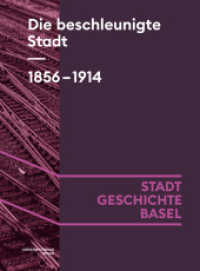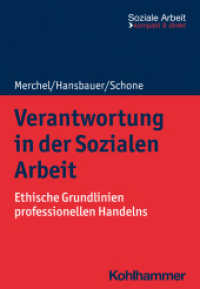Full Description
The Working Papers of Hugo Grotius is the first full-length study of the handwritten documents initially used by the author of Mare Liberum (1609) and De Jure Belli ac Pacis (1625) in his day-to-day activities as a scholar, lawyer, and politician, but subsequently incorporated into his own or other archives. Martine van Ittersum reconstructs a process of transmission, dispersal, and loss that started during Grotius' lifetime and ended with the papers' auction in 1864. This is also a study of archival afterlives. Our understanding of Grotius' life and work is shaped by the conscious decisions of previous generations to retain or discard documents, frequently for the sake of individual lives and careers, family honour and/or larger political and religious ends.
Contents
Acknowledgements
List of Maps and Figures
1 Introduction: Hugo Grotius and the Microsociologies of Archives
1 Early Modern Scholars and Textual Production and Loss
2 The Role of Material Wealth in Preserving Personal Archives and Libraries
3 The Materiality of Texts and the Microsociologies of Archives
4 The Life and Times of Hugo Grotius
5 The Fate of Grotius' Working Papers
2 Knowledge Production and Records Management in Early Modern Europe: The Case of Hugo Grotius (1583-1645)
1 Grotius' Working Methods as a Lawyer and Government Official
2 Is There a Start Date for Grotius' Personal Archive?
3 Where Did Grotius Keep His Books and Papers?
4 The Working Methods of an Early Modern Scholar
5 Access to Printed and Manuscript Materials
6 How Grotius Involved His Relatives and Remonstrant Friends in Knowledge Production
7 Circulating Manuscripts in the Republic of Letters
8 The Role of Grotius' Relatives and Remonstrant Friends in Printed Publication
9 Conclusion
3 Confiscated Manuscripts and Books
What Happened to Grotius' Personal Library and Archive Following His Arrest on Charges of High Treason in August 1618?
1 What Is Known Already About the Confiscation of Grotius' Books and Working Papers in the Period 1618-1620?
2 Did Grotius' Relatives Squirrel Away Sensitive Materials Following His Arrest in August 1618?
3 To Which Books and Manuscripts Did Grotius Have Access in Captivity?
4 How Jan De Groot Recovered Some of His Son's Books and Papers in Summer 1621
5 What Happened to Grotius' Confiscated Papers?
6 What Happened to Grotius' Confiscated Books?
7 Conclusion
4 Creating a (Definitive) Corpus of Writings: How Grotius' Employer, Relatives, and Remonstrant Friends Shaped His Intellectual Legacy (1645-1679)
1 Grotius' Intellectual Legacy as a Family Project
2 What Happened to the Book Collection Sold to Christina of Sweden?
3 Manuscript Hunters in Paris, London, and the Low Countries
4 Pieter De Groot's Stewardship of His Father's Working Papers (1653-1660)
5 Grotius' Intellectual Legacy in the Era of the 'True Freedom' and Beyond (1660-1678)
6 What Happened to the Working Papers Inherited by the Descendants of Willem De Groot?
7 Conclusion
5 Preserving and Editing Grotius' Manuscripts for the Sake of Family Honor and the Remonstrant Cause (1679-1747)
1 Publishing, Advertising and Deconstructing Epistolae Quotquot Reperiri Potuerunt
2 A Remonstrant Hero: How Jean Le Clerc Shaped Grotius' Intellectual Legacy
3 Circulating Manuscripts in the Republic of Letters in the Eighteenth Century
4 Writing and Publishing an Authoritative Biography of Hugo Grotius
5 Memorialization through Physical Artifacts
6 The Cornets De Groot Family in Bergen op Zoom
7 Conclusion
6 Confronting Grotius' Legacy in an Age of Revolution: The Cornets De Groot Family in Rotterdam (1748-1798)
1 The Cornets De Groot Family as Beneficiaries of the Stadtholders' Patronage
2 The Establishment of a Grotius Memorial in the New Church in Delft
3 A Patriot Revolution in Rotterdam
4 The Patriot Politics of Paulus Gevers
5 Hugo Grotius and Pieter De Groot as Patriot Icons
6 Jan Cornets De Groot's Efforts to Overturn the Patriot Revolution in Rotterdam
7 Papers, Portraits, and Memorabilia Passed Down the Generations
8 Status Symbols: Ancestral Portraits and Grotius Memorabilia
9 An Inventory of the Papers of Hugo Grotius and Pieter De Groot (April 1778)
7 Constructing a Conservative National Hero in Response to Patriot Radicalism (1787-1815)
1 Grotius as the Embodiment of Republican Virtue
2 The Rediscovery of the Parallelon Rerumpublicarum and the Making of a Dutch National Hero
3 What Can the Visser Collection Tell Us about the Transmission and Dispersal of Grotius' Working Papers?
4 How Jacobus Scheltema Rearranged Grotius' Working Papers and Marked Up the 1778 Inventory
8 End of the Lineage: How Hugo Cornets De Groot Disposed of His Grotiana (1802-1864)
1 A Visit from Lieutenant-General A.W.H. Nolthenius De Man in March 1832
2 An Epistolary Exchange between Johan Pieter Cornets De Groot Van Kraaijenburg and Distant Relatives in Cuyck and Nijmegen
3 Why Did Hugo Cornets De Groot Become Estranged from His Relatives?
4 The Death of a Lonely Bachelor in Cuyck in February 1864
5 How Jean Baptiste Regouin Rearranged the Working Papers of Hugo Grotius and Pieter De Groot, and Then Sold These to a Tobacco Merchant
9 Preparing for the Auction of the Working Papers of Hugo Grotius and Pieter De Groot, Mostly Behind the Scenes (February-November 1864)
1 Christiaan Snelleman, Rotterdam Merchant and Remonstrant
2 A List of Grotiana Compiled by the Remonstrant Minister C.P. Tiele
3 How P.A. Tiele Put Together an Auction Catalogue, and Divided Up Manuscript Volumes into Multiple Lots
4 The Auctioneer Martinus Nijhoff
5 How Frederik Muller Did Business with the Nederlandsche Handel-Maatschappij
10 The 1864 Auction of the Working Papers of Hugo Grotius and Pieter De Groot, and What Happened Next
1 How Nijhoff Conducted the Auction and Presented Its Outcome to the Public
2 The Story Behind the Swedish Government's Acquisition of Grotiana
3 What Happened to Lots 1-42?
4 The Bid and Strike Prices of Lots 43-99, and the Potential and Actual Buyers
5 The 1864 Auction in Comparative Context
6 What Explains the Dutch Government's Total Lack of Involvement?
7 How Johan Pieter Cornets De Groot Van Kraaijenburg (Re)Assembled a Collection of Family Papers
11 Conclusion
Appendix 1: The 1778 Inventory of the Working Papers of Hugo Grotius and Pieter De Groot, With Notes by Jacobus Scheltema
Appendix 2: Jacobus Scheltema's Rearrangement of the Papers of Hugo Grotius and Pieter De Groot (May 1803)
Appendix 3: "Short Description of the Contents of the Enclosed Books, Volumes of Letters, Parchments with Seals Attached to Them, etc., Left by Hugo Grotius"
Appendix 4: A List of Grotiana Compiled by C.P. Tiele, at the Request of Christiaan Snelleman (August 1864)
Appendix 5: The Auction of the Working Papers of Hugo Grotius and Pieter De Groot: Bid Prices, Strike Prices, and Horse Trading Behind the Scenes (November 1804)
Appendix 6: The Auction Proceeds: The Final Receipt Sent to Christiaan Snelleman by Martinus Nijhoff
Appendix 7: Grotius' Working Papers as Rearranged by P.A. Tiele
Appendix 8: Inheriting Ancestral Portraits and Papers: A Genealogical Chart
Bibliography
Indices








